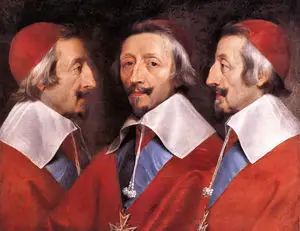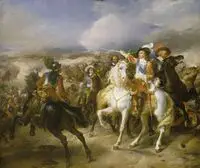Difference between revisions of "How did Cardinal Richelieu change France"
| Line 5: | Line 5: | ||
Richelieu was also able to use the Thirty Years War to further the national interests of France and he, more than anyone else, made France the greatest power in Europe by the second half of the seventeenth century. However, these achievements, while significant were a catastrophe for most French citizens. | Richelieu was also able to use the Thirty Years War to further the national interests of France and he, more than anyone else, made France the greatest power in Europe by the second half of the seventeenth century. However, these achievements, while significant were a catastrophe for most French citizens. | ||
| − | ==== | + | ====Why was France divided before the arrival of Cardinal Richelieu?==== |
In the early seventeenth century France was one of the leading powers in Europe, but it was very divided and vulnerable. It was surrounded by the Hapsburgs who controlled the Low Countries and Spain. The kingdom was also very divided because of religion. Europe was torn by religious conflict and in 1618 the Thirty Years War broke out, and much of the continent was dragged into the conflict between Catholic and Protestant.<ref> Bergin, Joseph. <i>The Rise of Richelieu</i> (Manchester: Manchester University Press, 1997), p. 34</ref> The international situation was destabilizing French society which was divided between Catholic and Protestant (Huguenot). The Edict of Nantes had granted French Protestants religious toleration, and this community effectively ran their own ‘parallel state.’ There were continued tensions between Catholics and Protestants, and this frequently exploded into riot and violence. The Catholic community itself was divided between hardliners and those who took a more pragmatic approach to religion. The country itself was still largely a feudal society.<ref>Bergin, p. 13</ref> | In the early seventeenth century France was one of the leading powers in Europe, but it was very divided and vulnerable. It was surrounded by the Hapsburgs who controlled the Low Countries and Spain. The kingdom was also very divided because of religion. Europe was torn by religious conflict and in 1618 the Thirty Years War broke out, and much of the continent was dragged into the conflict between Catholic and Protestant.<ref> Bergin, Joseph. <i>The Rise of Richelieu</i> (Manchester: Manchester University Press, 1997), p. 34</ref> The international situation was destabilizing French society which was divided between Catholic and Protestant (Huguenot). The Edict of Nantes had granted French Protestants religious toleration, and this community effectively ran their own ‘parallel state.’ There were continued tensions between Catholics and Protestants, and this frequently exploded into riot and violence. The Catholic community itself was divided between hardliners and those who took a more pragmatic approach to religion. The country itself was still largely a feudal society.<ref>Bergin, p. 13</ref> | ||
Revision as of 16:29, 28 October 2019
Cardinal Richelieu (1585-1642) was one of the most significant leaders in France because he both strengthened and consolidated the power of the monarchy. He was chief minister to Louis XIII, and he changed the nature of French government and society. Today, he is best known as a character in Alexander Dumas’ classic novel, The Three Musketeers. Richelieu was a master politician and diplomat, who used of his influence to lay the foundations of an ‘absolute monarchy’ in France.
Richelieu was also able to use the Thirty Years War to further the national interests of France and he, more than anyone else, made France the greatest power in Europe by the second half of the seventeenth century. However, these achievements, while significant were a catastrophe for most French citizens.
Why was France divided before the arrival of Cardinal Richelieu?
In the early seventeenth century France was one of the leading powers in Europe, but it was very divided and vulnerable. It was surrounded by the Hapsburgs who controlled the Low Countries and Spain. The kingdom was also very divided because of religion. Europe was torn by religious conflict and in 1618 the Thirty Years War broke out, and much of the continent was dragged into the conflict between Catholic and Protestant.[1] The international situation was destabilizing French society which was divided between Catholic and Protestant (Huguenot). The Edict of Nantes had granted French Protestants religious toleration, and this community effectively ran their own ‘parallel state.’ There were continued tensions between Catholics and Protestants, and this frequently exploded into riot and violence. The Catholic community itself was divided between hardliners and those who took a more pragmatic approach to religion. The country itself was still largely a feudal society.[2]
The local nobility and magnates dominated the localities, and they were the de-facto rulers in their lands. The great noble families such as the Conde owned massive estates and they even had their private armies. These noble families owed more allegiance to themselves than to France. The nobility was factionalized, and they constantly quarreled and also fought each other to gain influence and even intrigued with the Hapsburgs against their king.[3] The actual power of the monarch was minimal. The king in France was dependent upon the nobles to raise taxes and an army. If the aristocrats did not want to cooperate with the king, he was in great difficulties. Many found this situation intolerable and demanded reforms, especially the middle class and urban elites.
Who was Cardinal Richelieu?
Cardinal Richelieu was born in 1585, during one of France’s many Religious Wars. Richelieu was the son of the Lord of Richelieu and a member of the minor nobility.[4] He was educated in Paris at the Collège de Navarre, a brilliant student he was well-versed in history and the classics. He had originally been intended for the military, but his family decided that he should enter the priesthood. In April 1607, after receiving a papal dispensation as he was only 21, he was ordained as a priest and bishop at Lucon. Richelieu was very ambitious and studied the works of Machiavelli. The extent of the influence of the Italian political philosopher can be seen in Richelieu’s cynical aphorisms, especially in his Testament Politique (1641).
His most famous epigram is ‘one may use all means against one’s enemies.’[5] By 1614 the young prelate had achieved a reputation as a capable administrator and regularly attended meetings of the Estates-General (French Parliament), where his oratory impressed many. Richelieu was a member of the dévot party and a very strong supporter of Roman Catholicism and held pro-Spanish views.[6]
The young bishop came to the attention of the queen-regent, Marie de Medici, who asked Richelieu to attend the Royal Court. Richelieu became chaplain of the young Queen Anne in 1615. She was the wife of Louis XII, who was too young to rule in his name and power rested with his mother, Marie de Medici. Richelieu was a political genius, and soon he was appointed Secretary of State for War. However, his patron Marie de Medici fell from grace with the king because of court-politics, and it seemed that Richelieu’s career was over.[7] However, Richelieu managed to reconcile the queen-mother and her son, and he eventually was rewarded with the position of Chief Minister and with the backing of Louis XII he began the transformation of French society.
The king also secured a Cardinal’s hat for Richelieu. The French statesman was committed to furthering the power of the monarchy and France. In pursuit of this, he attacked the Huguenots and began to erode their power base. He reformed the navy and the army. He also reorganized the bureaucracy and sought to curb the power of the nobles. Much of his time in power was an effort to centralize power. He was dependent upon the king’s favor and confidence but Louis XIII, an indolent and enigmatic man, gave Richelieu, great leeway to pursue the policies that he thought were best for the kingdom. The Cardinal was often embroiled in disputes with noble factions, but the support of the monarch allowed him to initiate fundamental reforms and radical policies.
The Cardinal sought to establish an Absolute Monarchy in France, where the king would be, obeyed through the land and the feudal nobility no longer acted like independent lords. He suppressed several conspiracies and rebellions and limited the powers of the nobility.[8] Richelieu was very much a ‘realist’ in international affairs, and he allied himself with Protestant nations, though a Catholic to strengthen the position of his beloved France in Europe. He intervened in the Thirty Years War and changed the direction of that conflict. Richelieu died hated by many in 1642, and his work was continued by his handpicked successor Cardinal Mazarin, who completed his old master's work and created an absolute monarchy in France.
Government Reform
Richelieu made sweeping changes to the way that France was governed he expanded the standing army and the navy. He also made sure that the Royal Treasury regularly funded them for the first time. Richelieu was eager to remove the influence of the nobility from the bureaucracy, and he opened the civil service to commoners. However, many of these bought their positions and this lead to nepotism and corruption in the later years of Richelieu’s.[9] The Cardinal did make the bureaucracy more efficient and made sure that the royal budget was balanced. His most important reforms were in local government. Traditionally the local notables had been free to do what they like; they were expected to administer their district.

This was a relic of feudalism and Richelieu believed that it was not suitable for a modern state. He persuaded Louis XIII to appoint an ‘intendant’ or official to every district, and they would administer the area. This did much to reduce the influence of the local notables, but they still had immense powers. The appointment of government officials did much to curb the authority and freedom of provincial nobles. Richelieu administrative reforms did much to change France from a feudal to a modern state. However, this was arguably not finished until the French Revolution. Richelieu also had many castles and fortresses demolished, and this reduced the ability of the nobility to defy their monarch. However, they were still able to recruit large private armies from among their tenants and retainers. The new administration also meant more taxes for the peasantry, and there were many peasant uprisings during the Cardinal’s ministry.[10]
Huguenots
The Huguenots were perhaps the strongest faction in the country, and they had a significant army and were supported by Charles I of England. Richelieu attempted to revoke many of the privileges that were granted to the Huguenots under the Edict of Nantes. This action led to a rebellion and Richelieu besieged one of their main strongholds La Rochelle. The Cardinal personally directed this siege, and he imitated the siege tactics of Alexander the Great to capture the strategic port.
The Huguenots continued their rebellion but the Cardinal was implacable, and the Royalist army defatted the French Protestants in battle.[11] This forced the Huguenot leader to seek terms with the king. Richelieu adopted a conciliatory policy towards them was influenced by personal philosophy ‘First, all means to conciliate; failing that, all means to crush.’[12] If the Huguenots had not obeyed the Cardinal’s will he would have waged total war against them. Richelieu eventually appointed the Huguenot leader to a senior position in the army and integrated some Huguenot soldiers into the Royal army. The Cardinal at the same time, under the Peace of Alais, the Protestants still had religious freedom, but they were shorn of their military and political rights.
Thirty Years War
Richelieu was unique among statesmen of the time as he put the needs of his king before that of his religion. He devised a strategy that promoted and safeguarded the geopolitical interests of France. Despite being an early adherent of the Devot party, he was determined to limit the power of his fellow Catholics the Hapsburgs.[13]
This dynasty ruled in Spain and Austria, and they dominated much of Europe. For over a hundred years they had threatened France or interfered in her internal affairs when he became Minister he adopted a determined anti-Hapsburg policy. He supported, through subsidies various Protestant armies in Germany that were fighting the Catholic armies of the Hapsburgs. In 1629 when the Hapsburgs seemed on the point of victory, he encouraged the Swedes to invade Germany. This was not enough for Richelieu and he had French armies fight against the Spanish Hapsburgs in Northern Italy and even in Spain itself (Catalonia).
The Cardinal used all the resources of France to contain and defeat the Hapsburgs. He was concerned that the Hapsburgs sought to encircle and conquer France. He raised taxes to pay for the military campaigns. The increased taxes disproportionately targeted ordinary families and even caused localized famines. However, Richelieu policies were continued with, and they eventually led to the French victory over the Spanish Hapsburgs at Lens in 1648. This is widely regarded as the end of the Hapsburgs supremacy in Europe and was a victory that saw the emergence of France as the most significant power in Europe. Richelieu did not live to implement all his plans, but he undoubtedly helped make France the preeminent power in seventeenth-century Europe.
Richelieu and the French Empire
Not only did Richelieu help to make France the greatest power in Europe he was also instrumental in the establishment of a French overseas Empire. His reforms of the Navy meant that the French could secure new colonies, especially in the eighteenth century. When he came to power the French colony in New France (Canada) was in decline. He revived the fortunes of the colony by the formation of the ‘Company of New France’.
This shift helped to boost trade between the colony and France, and this encouraged many French emigrants to settle in the territory. Richelieu encouraged the settlers to live in harmony with the Native Americans, and this did much to strengthen the French colony. The Cardinal was one of the pivotal figures in the history of Quebec and Francophone Canada.
Conclusion
Richelieu was one of the greatest figures in Early Modern Europe. He changed France from a feudal society into a modern state. He was instrumental in the establishment of the Absolute Monarchy in France because he managed to curb the power of the French nobility. His foreign policy effectively ended the Hapsburg threat to France and made her one of, or perhaps the most powerful kingdom on the continent.
Richelieu, died before his policies came to fruition but his protégé Mazarin ensured that the plans of the Cardinal were carried out. This meant that French society was utterly changed. Richelieu also had a very modern outlook, and he created the apparatus of a modern nation-state and laid the foundations for the future French Empire in North America. His last words to the king, before he died, sum up his achievements.[14]
I have the consolation of leaving your kingdom in the highest degree of glory and reputation. However, all of this came at a cost. After his death, the French nobility revolted in two wars known as the Frondes, that devastated France. His military campaigns and administrative reforms led to widespread poverty, rebellion, and famine in the countryside. Richelieu did make France great, but in doing so, he caused many millions to suffer. No wonder he was such a divisive figure, who was either hated or loved.
References
- ↑ Bergin, Joseph. The Rise of Richelieu (Manchester: Manchester University Press, 1997), p. 34
- ↑ Bergin, p. 13
- ↑ Collins, James B. The State in Early Modern France (Cambridge: Cambridge University Press 1995), p. 15
- ↑ Bergin, p. 4
- ↑ Richelieu, Political Testament, 1662, p. 9
- ↑ Collins, p. 13
- ↑ Levi, Anthony. Cardinal Richelieu and the Making of France. New York: Carroll and Graf, 2000), p. 112
- ↑ Collins, p. 115
- ↑ Collins, p. 115
- ↑ Bergin, p. 116
- ↑ Levi, p. 113
- ↑ Richelieu, Political Statement. (1663), p. 13
- ↑ Levi, p. 123
- ↑ Collins, p. 114
Reviewed Januray 29, 2019. Admin, Ewhelan and EricLambrecht


